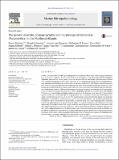The genetic diversity, phylogeography and morphology of Elphidiidae (Foraminifera) in the Northeast Atlantic
Abstract
Genetic characterisation (SSU rRNA genotyping) and Scanning Electron Microscope (SEM) imaging of individual tests were used in tandem to determine the modern species richness of the foraminiferal family Elphidiidae (Elphidium, Haynesina and related genera) across the Northeast Atlantic shelf biomes. Specimens were collected at 25 locations from the High Arctic to Iberia, and a total of 1013 individual specimens were successfully SEM imaged and genotyped. Phylogenetic analyses were carried out in combination with 28 other elphidiid sequences from GenBank and seventeen distinct elphidiid genetic types were identified within the sample set, seven being sequenced for the first time. Genetic types cluster into seven main clades which largely represent their general morphological character. Differences between genetic types at the genetic, morphological and biogeographic levels are indicative of species level distinction. Their biogeographic distributions, in combination with elphidiid SSU sequences from GenBank and high resolution images from the literature show that each of them exhibits species-specific rather than clade-specific biogeographies. Due to taxonomic uncertainty and divergent taxonomic concepts between schools, we believe that morphospecies names should not be placed onto molecular phylogenies unless both the morphology and genetic type have been linked to the formally named holotype, or equivalent. Based on strict morphological criteria, we advocate using only a three-stage approach to taxonomy for practical application in micropalaeontological studies. It comprises genotyping, the production of a formal morphological description of the SEM images associated with the genetic type and then the allocation of the most appropriate taxonomic name by comparison with the formal type description. Using this approach, we were able to apply taxonomic names to fifteen genetic types. One of the remaining two may be potentially cryptic, and one is undescribed in the literature. In general, the phylogeographic distribution is in agreement with our knowledge of the ecology and biogeographical distribution of the corresponding morphospecies, highlighting the generally robust taxonomic framework of the Elphidiidae in time and space.
Citation
Darling , K F , Schweizer , M , Knudsen , K L , Evans , K M , Bird , C , Roberts , A , Filipsson , H L , Kim , J-H , Gudmundsson , G , Wade , C M , Sayer , M D J & Austin , W E N 2016 , ' The genetic diversity, phylogeography and morphology of Elphidiidae (Foraminifera) in the Northeast Atlantic ' , Marine Micropaleontology , vol. 129 , pp. 1-23 . https://doi.org/10.1016/j.marmicro.2016.09.001
Publication
Marine Micropaleontology
Status
Peer reviewed
ISSN
0377-8398Type
Journal article
Description
This work was funded by the Natural Environment Research Council (NERC) of the United Kingdom (grant NE/G020310/1 to K.D., W.E.N.A. and M.S.) and the Carnegie Trust for the Universities of Scotland. M.S. was supported by the Swiss National Science Foundation (SNSF, fellowships for advanced researchers PA00P2_126226 and PA00P2_142065).Collections
Items in the St Andrews Research Repository are protected by copyright, with all rights reserved, unless otherwise indicated.

